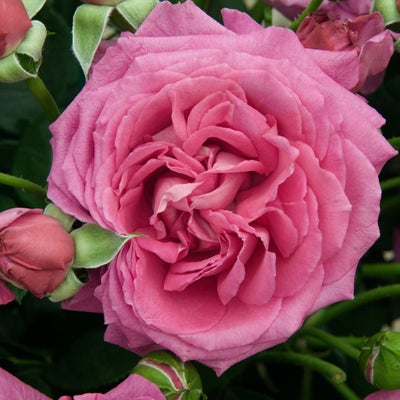
Quick facts
Suitable for - All bush roses
Timing - Late winter to early spring
Difficulty - Moderate
Suitable for...
This method is suitable for all bush roses, whether they are teas or floribundas. If you have a bush rose, and don’t know what type it is, the best way to tell is by looking at the flowering habit.
Both types are repeat-flowering. , (also called large-flowered roses) usually have only one flower per stem and tend to flower in three flushes from summer to late autumn. Floribundas (also called cluster-flowered roses) have many flowers per stem and tend to repeat-flower continuously from summer to late autumn.
If you inherit an overgrown rose and don’t know what type it is (and don’t want to wait until summer when it flowers), it is best to prune as for a hybrid tea.
When to prune floribunda and hybrid tea roses
Roses can be pruned during late winter when growth is just resuming, usually in mid-February in the south, but in northern and colder areas wait until March.
How to prune
(cluster-flowered) and teas (large-flowered) are pruned following largely similar techniques. The only difference is that floribunda stems are left longer with more on them to form the characteristic mass of flowers while hybrid teas are pruned low to promote vigorous new shoots.
To start with, cut out dead, diseased, rubbing and crossing stems. If the bush is crowded cut out some old shoots completely to keep the centre open.
Then proceed as for hybrid tea or floribunda roses, as follows:
Hybrid tea (large-flowered): pruning group 15
- Shorten back the strongest remaining shoots to four to six buds 10-15cm (4-6in) from the base, to the point where last year’s growth began
- Shorten back less vigorous shoots to two to four buds 5-10cm (2-4in) from the base
- At Wisley the aim is to cut out all three year old wood, leaving only younger more vigorous growths, which produce better flowers
Floribunda (cluster-flowered): pruning group 16
- Cut back the strongest remaining shoots down to within 25-30cm (10in-1ft) of soil level
- Prune back less vigorous shoots more severely
- Occasionally some older stems can be pruned hard back to a few inches from soil level. This encourages stronger growth from the base
Guidance on pruning other types of roses can be found on separate pages;
Problems
Wear gloves when handling thorny roses and keep a watch when you are pruning for the following pests or diseases while pruning; rose aphids, rose large sawfly, rose leaf rolling sawfly, rose black spot, rose dieback, rose powdery mildew and rose rust.
Blindness (lack of flowers) can also be a problem in roses.





